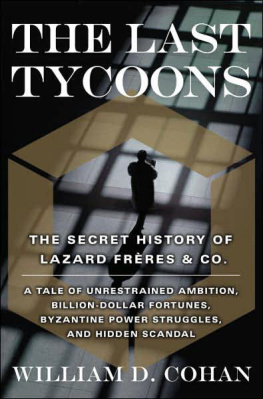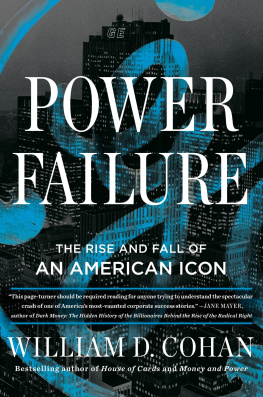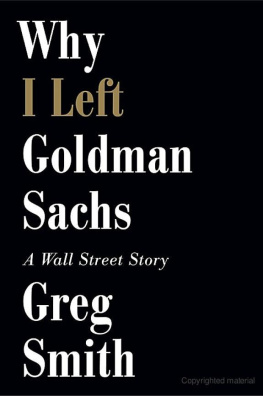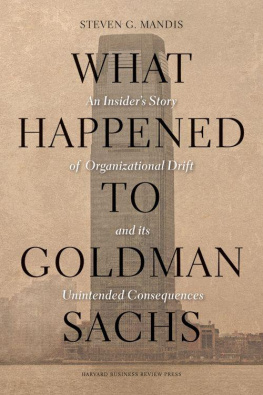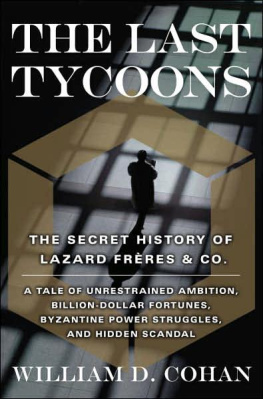William D. Cohan - Money and Power: How Goldman Sachs Came to Rule the World
Here you can read online William D. Cohan - Money and Power: How Goldman Sachs Came to Rule the World full text of the book (entire story) in english for free. Download pdf and epub, get meaning, cover and reviews about this ebook. year: 2011, publisher: Doubleday, genre: Detective and thriller. Description of the work, (preface) as well as reviews are available. Best literature library LitArk.com created for fans of good reading and offers a wide selection of genres:
Romance novel
Science fiction
Adventure
Detective
Science
History
Home and family
Prose
Art
Politics
Computer
Non-fiction
Religion
Business
Children
Humor
Choose a favorite category and find really read worthwhile books. Enjoy immersion in the world of imagination, feel the emotions of the characters or learn something new for yourself, make an fascinating discovery.

- Book:Money and Power: How Goldman Sachs Came to Rule the World
- Author:
- Publisher:Doubleday
- Genre:
- Year:2011
- Rating:4 / 5
- Favourites:Add to favourites
- Your mark:
- 80
- 1
- 2
- 3
- 4
- 5
Money and Power: How Goldman Sachs Came to Rule the World : summary, description and annotation
We offer to read an annotation, description, summary or preface (depends on what the author of the book "Money and Power: How Goldman Sachs Came to Rule the World " wrote himself). If you haven't found the necessary information about the book — write in the comments, we will try to find it.
Money and Power: How Goldman Sachs Came to Rule the World — read online for free the complete book (whole text) full work
Below is the text of the book, divided by pages. System saving the place of the last page read, allows you to conveniently read the book "Money and Power: How Goldman Sachs Came to Rule the World " online for free, without having to search again every time where you left off. Put a bookmark, and you can go to the page where you finished reading at any time.
Font size:
Interval:
Bookmark:
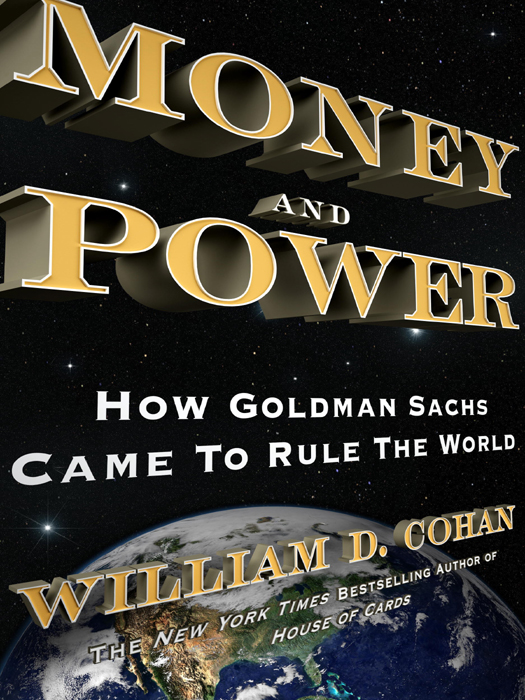
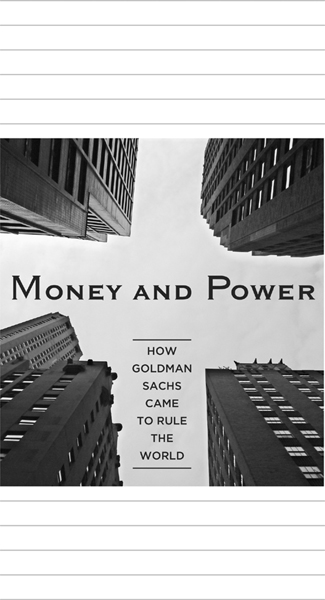

Copyright 2011 by William D. Cohan
All rights reserved. Published in the United States by Doubleday, a division of Random House, Inc., New York, and in Canada by Random House of Canada Limited, Toronto.
www.doubleday.com
DOUBLEDAY and the portrayal of an anchor with a dolphin are registered trademarks of Random House, Inc.
Portions of this work were previously published in Vanity Fair.
Grateful acknowledgment is made to the Columbia University Oral History Research Office Collection.
Jacket design by John Fontana
Jacket illustration by Serial Cut
Title page photograph by Marco Di Fabio / Flickr / Getty Images
Cataloging-in-Publication Data is on file with the Library of Congress.
eISBN: 978-0-385-53497-0
v3.1_r1
A LSO BY THE AUTHOR
The Last Tycoons
House of Cards
T O Q UENTIN , D EB, AND T EDDY
T HE P YRRHIC V ICTORY
W all Street has always been a dangerous place. Firms have been going in and out of business ever since speculators first gathered under a buttonwood tree near the southern tip of Manhattan in the late eighteenth century. Despite the ongoing risks, during great swaths of its mostly charmed 142 years, Goldman Sachs has been both envied and feared for having the best talent, the best clients, and the best political connections, and for its ability to alchemize them into extreme profitability and market prowess.
Indeed, of the many ongoing mysteries about Goldman Sachs, one of the most overarching is just how it makes so much money, year in and year out, in good times and in bad, all the while revealing as little as possible to the outside world about how it does it. Anotherequally confoundingmystery is the firms steadfast, zealous belief in its ability to manage its multitude of internal and external conflicts better than any other beings on the planet. The combination of these two genetic strainsthe ability to make boatloads of money at will and to appear to manage conflicts that have humbled, then humiliated lesser firmshas made Goldman Sachs the envy of its financial-services brethren.
But it is also something else altogether: a symbol of immutable global power and unparalleled connections, which Goldman is shameless in exploiting for its own benefit, with little concern for how its success affects the rest of us. The firm has been described as everything from a cunning cat that always lands on its feet to, now famously, a great vampire squid wrapped around the face of humanity, relentlessly jamming its blood funnel into anything that smells like money, by Rolling Stone writer Matt Taibbi. The firms inexorable success leaves people wondering: Is Goldman Sachs better than everyone else, or have they found ways to win time and time again by cheating?
But in the early twenty-first century, thanks to the fallout from Goldmans very success, the firm is looking increasingly vulnerable. To be sure, the firm has survived plenty of previous crises, starting with the Depression, when much of the firms capital was lost in a scam of its own creation, and again in the late 1940s, when Goldman was one of seventeen Wall Street firms put on trial and accused of collusion by the federal government. In the past forty years, as a consequence of numerous scandals involving rogue traders, suicidal clients, and charges of insider trading, the firm has come far closerrepeatedlyto financial collapse than its reputation would attest.
Each of these previous threats changed Goldman in some meaningful way and forced the firm to adapt to the new laws that either the market or regulators imposed. This time will be no different. What is different for Goldman now, though, is that for the first time since 1932when Sidney Weinberg, then Goldmans senior partner, knew that he could quickly reach his friend, President-elect Franklin Delano Rooseveltthe firm no longer appears to have sympathetic high-level relationships in Washington. Goldmans friends in high places, so crucial to the firms extraordinary success, are abandoning it. Indeed, in todays charged political climate, which is polarized along socioeconomic lines, Goldman seems particularly isolated and demonized.
Certainly Lloyd Blankfein, Goldmans fifty-six-year-old chairman and CEO, has no friend in President Barack Obama, despite being invited to a recent state dinner for the president of China. According to Newsweek columnist Jonathan Alters book The Promise, the angriest Obama got during his first year in office was when he heard Blankfein justify the firms $16.2 billion of bonuses in 2009 by claiming Goldman was never in danger of collapse during the financial crisis that began in 2007. According to Alter, President Obama told a friend that Blankfeins statement was flatly untrue and added for good measure, These guys want to be paid like rock stars when all theyre doing is lip-synching capitalism.
Complicating the firms efforts to be better understood by the American publica group Goldman has never cared to serveis a long-standing reticence among many of the firms current and former executives, bankers, and traders to engage with the media in a constructive way. Even retired Goldman partners feel compelled to check with the firms disciplined administrative bureaucracy, run by John F. W. Rogersa former chief of staff to James Baker, both at the White House and at the State Departmentbefore agreeing to be interviewed. Most have likely signed confidentiality or nondisparagement agreements as a condition of their departures from the firm. Should they make themselves available, unlike bankers and traders at other firmswhere self-aggrandizement in the press at the expense of colleagues is typicalGoldman types stay firmly on the message that what matters most is the Goldman team, not any one individual on it.
Theyre extremely disciplined, explained one private-equity executive who both competes and invests with Goldman. They understand probably better than anybody how to never take the game face off. Youll never get a Goldman banker after three beers saying, You know, listen, my colleagues are a bunch of fucking dickheads. They just dont do that the way other guys will, whether its because they tend to keep the uniform on for a longer stretch of time so theyre not prepared to damage their squad, or whether or not its because theyre afraid of crossing the powers that be, once theyve taken the blood oath they maintain that discipline in a kind of eerily successful way.
A NYONE WHO MIGHT have forgotten how dangerous Wall Street can be was reminded of it again, in spades, beginning in early 2007, as the market for home mortgages in the United States began to crack, and then implode, leading to the demise or near demise a year or so later of several large Wall Street firms that had been around for generationsincluding Bear Stearns, Lehman Brothers, and Merrill Lynchas well as other large financial institutions such as Citigroup, AIG, Washington Mutual, and Wachovia.
Although it underwrote billions of dollars of mortgage securities, Goldman Sachs avoided the worst of the crisis, thanks largely to a fully authorized, well-timed proprietary bet by a small group of Goldman tradersled by Dan Sparks, Josh Birnbaum, and Michael Swensonbeginning in December 2006, that the housing bubble would collapse and that the securities tied to home mortgages would rapidly lose value. They were right.
Font size:
Interval:
Bookmark:
Similar books «Money and Power: How Goldman Sachs Came to Rule the World »
Look at similar books to Money and Power: How Goldman Sachs Came to Rule the World . We have selected literature similar in name and meaning in the hope of providing readers with more options to find new, interesting, not yet read works.
Discussion, reviews of the book Money and Power: How Goldman Sachs Came to Rule the World and just readers' own opinions. Leave your comments, write what you think about the work, its meaning or the main characters. Specify what exactly you liked and what you didn't like, and why you think so.

